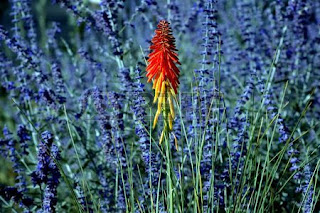Sometimes all we need to do is read our classics to learn about the present world.
Take the California drought, for example. The dry state has been experiencing four years of skimpy precipitation. Already a semi-arid climate, any dip in the rainfall can change the lifestyle dramatically. Produce goes up in price. Water restrictions are enforced, landscape irrigation practically prohibited.
On a recent trip to SoCal I observed the brown lawns first-hand. A green golf course excused itself with a sign off the freeway: "Irrigated with reclaimed water." The only other visibly green color was on the faces of residents driving by as reclaimed water was not available to them. Their St Augustine remains parched. The entire emotional climate was judgmental. Any gardens that suggested adequate watering, pronounced immediate indictment upon its owners.
We visited a nursery specializing in drought resistant plants, succulents and flowering grasses. One is considered very hip if you plant them on your property. Especially if you do it in torn jeans, rumpled hat and thrift store work boots. A paisley neckerchief to catch sweat tied loosely at the throat finishes off the look. So dressed the nursery employees, scruffy beards for the young men, no make-up for the girls.
The classic I'm referring to is John Steinbeck's East of Eden and his commentary on the California terrain. He paints a picture of the chaparral, the wildflowers and weather patterns in a way no film documentary ever could. Bringing every foggy recollection of the golden state's flowers back into vivid color, he writes of the seasonal blossoming. Having been away for seventeen years, I had nearly forgotten about the lupins, the poppies, the mustard and the Indian paintbrush that popped off the drab beige hills, the dirt lots by freeway on-ramps, and weedy shoulders of the streets.
"The spring flowers in a wet year were unbelievable.
The whole valley floor, and the foothills too, would be carpeted with lupins and poppies. Once a woman told me that colored flowers would seem more bright if you added a few white flowers to give the colors definition. Every petal of blue lupin is edged with white, so that a field of lupins is more blue than you can imagine. And mixed with these were splashes of California poppies. These too are of a burning color ---not orange, not gold, but if pure gold were liquid and could raise a cream, that golden cream might be like the color of the poppies. When their season was over the yellow mustard came up and grew to a great height. When my grandfather came into the valley the mustard was so tall that a man on horseback showed only his head above the yellow flowers.
And a little later in the season there would be red and yellow strands of Indian paintbrush.
And a little later in the season there would be red and yellow strands of Indian paintbrush.
These were the flowers of the open places exposed to the sun."
Then Steinbeck talks weather:
"I have spoken of the rich years when the rainfall was plentiful. But there were dry years too and they put a terror on the valley. The water came in a thirty year cycle. There would be five or six wet and wonderful years. When there might be nineteen to twenty-five inches of rain,
the land would shout with grass.
Then would come six or seven pretty good years of twelve to sixteen inches of rain. And then the dry years would come, and sometimes there would be only seven or eight inches of rain. The land dried up and the grasses headed out miserably a few inches high and great bare scabby places appeared in the valley. The live oaks got a crusty look and the sagebrush was gray. The land cracked and the springs dried up and the cattle listlessly nibbled dry twigs. Then the farmers and the ranchers would be filled with disgust for the Salinas Valley. The cows would grow thin and sometimes starve to death. People would have to haul in barrels of water to their farms just for drinking. Some families would sell out for nearly nothing and move away.
And it never failed that during the dry years the people forgot about the rich years,
and during the wet years they lost all memory of the dry years. It was always that way."
The author never mentions El Nino, the Golden State's great green hope. That term post-dated this story published sixty-three years ago.
Have the weathermen and bloggers forgotten their state's normal rain
cycles as Steinbeck suggests? Is the state of emergency that the Governor
has proclaimed soon to be lifted? Who knows?
What we do know is that the cracked lake-beds, the flinty soil, the dry man-made river bottoms will soon swell again with the cool winter watering that falls from the skies for one, two, three days at a time.
California can keep calm because this is the way of its weather, the normal course of its climate.
Thank you for the reminder, Mr. Steinbeck.





No comments:
Post a Comment